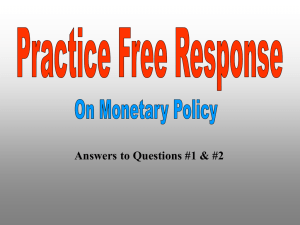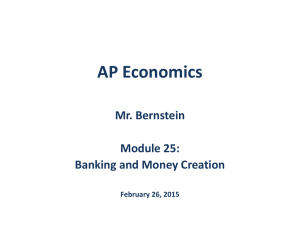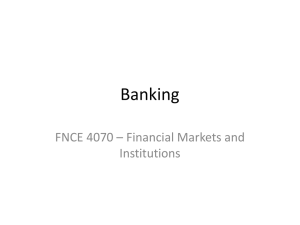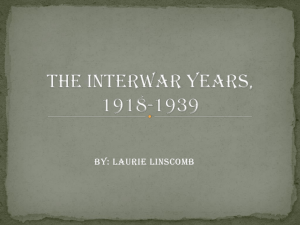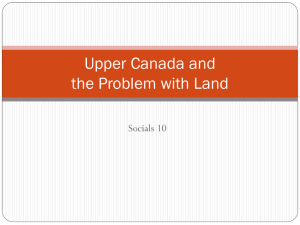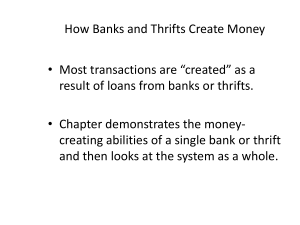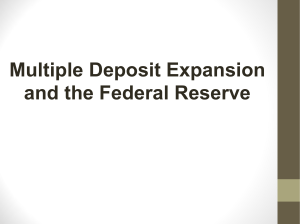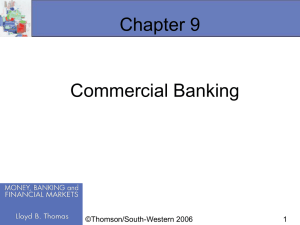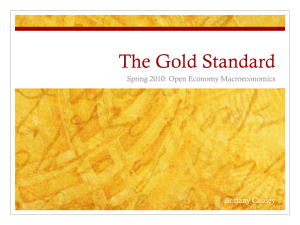Chapter 9
advertisement
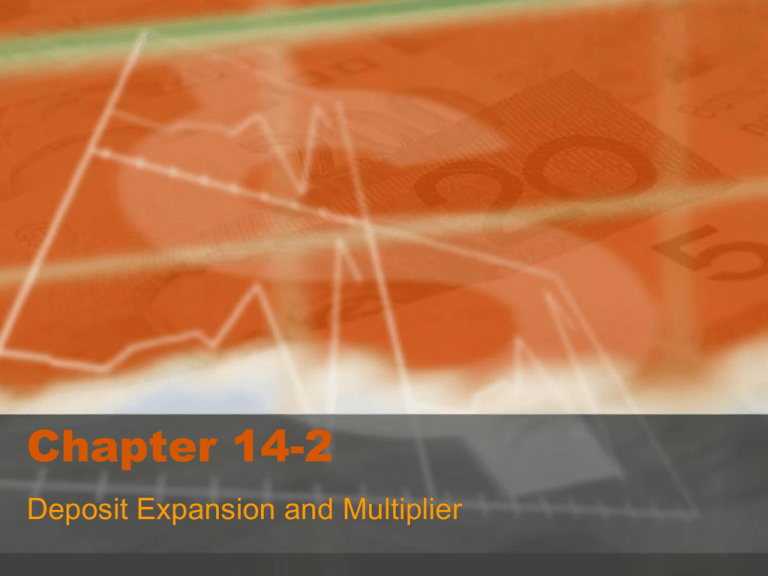
Chapter 14-2 Deposit Expansion and Multiplier Creating Money • Assume a student deposits $1000 from their piggy bank into a bank and receives a new checking account. Changing Composition • When someone deposits cash or coins in a bank, they are changing the composition of the money supply, not its size. Again Composition Not Size! • The deposit of funds into a bank does not change the size of the money supply. • It changes the composition of the money supply (transfers from cash to Checkable deposits). • Effect on the Money Supply of a Deposit at First Street Bank - Initial Effect Before Bank Makes New Loans • Effect on the Money Supply of a Deposit at First Street Bank - Effect After Bank Makes New Loans – Be careful No change means $1000 in checkable Deposit How Banks Create Money Money Creation University Bank Assets +$100.00 in coins Money Supply Liabilities +$100.00 in deposits Cash held by the public Transactions deposits at bank Change in M –$100 +$100 0 Money Creation University Bank Assets Liabilities +$100.00 in coins +$100 in loans +$100.00 in your account +$100.00 in borrower’s account Money Supply Cash held by the public Transactions deposits at bank Change in M no change +$100 +$100 Required Reserves • Required reserves are the minimum amount of reserves a bank is required to hold by government regulation; Equal to required reserve ratio times transactions deposits. Required reserves = minimum reserve ratio X total deposits How can they? The ability of banks to make loans depends on access to excess reserves. For Example • Example: If a bank is required to hold $20 in reserves but has $100 currently, it can lend out the $80 excess. Excess Reserves • Excess reserves are bank reserves in excess of required reserves. Excess reserves = Total reserves – Required reserves Excess Reserves • So long as a bank has excess reserves, it can make loans. Excess reserves are reserves a bank is not required to hold. New Loans = Creating Money • The creation of checkable deposits via new loans is the same thing as creating money. More Deposit Creation • As the excess reserves are loaned out again, more deposits are created and thus more money is created. Deposit Creation University Bank Assets Liabilities Required Reserves $20 Excess Reserves $80 Your account Total Assets $100 Total Liabilities $100 McGraw-Hill/Irwin Eternal Savings Assets Liabilities $100 Total Assets Total Liabilities © The McGraw-Hill Companies, Inc., 2003 Deposit Creation University Bank Assets Liabilities Required Reserves $36 Excess Reserves $64 Loans $80 Your account $100 Campus Radio account $ 80 Total Assets $180 Total Liabilities $180 McGraw-Hill/Irwin Eternal Savings Assets Total Assets Liabilities Total Liabilities © The McGraw-Hill Companies, Inc., 2003 Deposit Creation University Bank Assets Liabilities Eternal Savings Assets Liabilities Required Reserves $20 Excess Reserves $ 0 Loans $80 Your account $100 Campus Radio account $ 0 Required Reserves $16 Required Reserves $64 Atlas Antenna account $80 Total Assets $100 Total Liabilities $100 Total Assets $80 Total Liabilities $80 McGraw-Hill/Irwin © The McGraw-Hill Companies, Inc., 2003 Deposit Creation University Bank Assets Liabilities Eternal Savings Assets Liabilities Required Reserves $20 Excess Reserves $ 0 Loans $80 Your account $100 Campus Radio account $ 0 Required Reserves $29 Required Reserves $51 Loans $64 Atlas Antenna account $80 Herman’s Hardware account $64 Total Assets $100 Total Liabilities $100 Total Assets $144 Total Liabilities $144 McGraw-Hill/Irwin © The McGraw-Hill Companies, Inc., 2003 The Money Multiplier • Deposits created by one bank invariably end up as reserves in another bank. The Money Multiplier • This process can theoretically continue until all banks have zero excess reserves (no more loans can be made). The Money Multiplier • The money multiplier is the number of deposit (loan) dollars that the banking system can create from $1 of excess reserves. 1 Money multiplier = Required reserve requirement Excess Reserves as Lending Power • Each bank may lend an amount equal to its excess reserves and no more. Excess Reserves as Lending Power • The entire banking system can increase the volume of loans by the amount of excess reserves multiplied by the money multiplier. The Money Multiplier at Work Original deposit Bank A loans: Bank B loans Bank C loans Total money supply =$ =$ =$ =$ 100.00 80.00 [=0.8 x $100.00] 64.00 [=0.8 x $80.00] 51.20 [=0.8 x $64.00] = $ 500.00 Reserves, Bank Deposits, and the Money Multiplier Excess reserves are bank reserves over and above its required reserves. Increase in bank deposits from $1,000 in excess reserves = $1,000 + $1,000 × (1 − rr) + $1,000 × (1 − rr)2 + $1,000 × (1 − rr)3 + . . . this can be simplified to: Increase in bank deposits from $1,000 in excess reserves = $1,000/rr Did you get confused here is another Way • To find the total amount of deposits that will eventually be created, multiply the original deposited amount by 1/rr, where rr is the reserve ratio. Multiply by the Multiplier • If the original deposit is $100 and the reserve ratio is 10 percent, then: 1 1 10 r 10 10 X $100 = $1,000 Calculating the Money Multiplier • The simple money multiplier is the measure of the amount of money ultimately created per dollar deposited in the banking system. • It equals 1/rr when people hold no currency. Calculating the Money Multiplier • The higher the reserve ratio, the smaller the money multiplier, and the less money will be created. An Example of the Creation of Money • The first 7 rounds of the money creation process is illustrated on the following table. • Assume a deposit of $10,000 and a reserve ratio of 20 percent. An Example of the Creation of Money The Real Multiplier is Smaller • A dollar of currency in circulation does not support multiple dollars of Money supply • In a checkable deposit only system will have a simple multiplier The Money Multiplier in Reality The monetary base is the sum of currency in circulation and bank reserves. The money multiplier is the ratio of the money supply to the monetary base. What about the cash under my mattress? • The approximate real-world money multiplier in the economy is: 1 r c r = the percentage of deposits banks hold in reserve c = the ratio of money people hold in cash to the money they hold as deposits Real Multiplier • If banks keep 10 percent in reserve and the ratio of individuals’ cash holdings to their deposits is 25 percent, the real-world money multiplier is: 1 1 2.9 0.1 0.25 0.35 Economics in Action • If the public lose their confidence and decide to hold cash the multiplier will shrink. • Also the money multiplier decreases if banks keep excess reserves for safety reasons.
